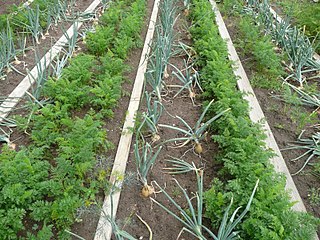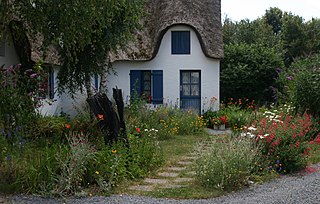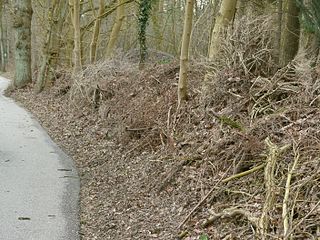
Companion planting in gardening and agriculture is the planting of different crops in proximity for any of a number of different reasons, including weed suppression, pest control, pollination, providing habitat for beneficial insects, maximizing use of space, and to otherwise increase crop productivity. Companion planting is a form of polyculture.

Biological control or biocontrol is a method of controlling pests, whether pest animals such as insects and mites, weeds, or pathogens affecting animals or plants by using other organisms. It relies on predation, parasitism, herbivory, or other natural mechanisms, but typically also involves an active human management role. It can be an important component of integrated pest management (IPM) programs.

A wildlife garden is an environment created with the purpose to serve as a sustainable haven for surrounding wildlife. Wildlife gardens contain a variety of habitats that cater to native and local plants, birds, amphibians, reptiles, insects, mammals and so on, and are meant to sustain locally native flora and fauna. Other names this type of gardening goes by can vary, prominent ones being habitat, ecology, and conservation gardening.

Beneficial insects are any of a number of species of insects that perform valued services like pollination and pest control. The concept of beneficial is subjective and only arises in light of desired outcomes from a human perspective. In agriculture, where the goal is to raise selected crops, insects that hinder the production process are classified as pests, while insects that assist production are considered beneficial. In horticulture and gardening, beneficial insects are often considered those that contribute to pest control and native habitat integration.

Pest control is the regulation or management of a species defined as a pest; such as any animal, plant or fungus that impacts adversely on human activities or environment. The human response depends on the importance of the damage done and will range from tolerance, through deterrence and management, to attempts to completely eradicate the pest. Pest control measures may be performed as part of an integrated pest management strategy.

The European hedgehog, also known as the West European hedgehog or common hedgehog, is a hedgehog species native to Europe from Iberia and Italy northwards into Scandinavia and westwards into the British Isles. It is a generally common and widely distributed species that can survive across a wide range of habitat types. It is a well-known species, and a favourite in European gardens, both for its endearing appearance and its preference for eating a range of garden pests. While populations are currently stable across much of its range, it is declining severely in Great Britain where it is now Red Listed, meaning that it is considered to be at risk of local extinction. Outside its native range, the species was introduced to New Zealand during the late nineteenth and early twentieth centuries.
In agriculture and gardening, a beneficial organism is any organism that benefits the growing process, including insects, arachnids, other animals, plants, bacteria, fungi, viruses, and nematodes. Benefits include pest control, pollination, and maintenance of soil health. The opposite of beneficial organisms are pests, which are organisms deemed detrimental to the growing process. There are many different types of beneficial organisms as well as beneficial microorganisms. Also, microorganisms have things like salt and sugar in them. Beneficial organisms include but are not limited to: Birds, Bears, Nematodes, Insects, Arachnids, and fungi. The ways that birds and bears are considered beneficial is mainly because they consume seeds from plant and spread them through feces. Birds also prey on certain insects that eat plants and hinder them from growing these insects are known as non beneficial organisms. Nematodes are considered beneficial because they will help compost and provide nutrients for the soil the plants are growing in. Insects and arachnids help the growing process because they prey on non beneficial organisms that consume plants for food. Fungi help the growing process by using long threads of mycelium that can reach very long distances away from the tree or plant and bring water and nutrients back to the tree or plant roots.

The Backyard Wildlife Habitat is a program of the National Wildlife Federation that encourages homeowners in the United States to manage their gardens and yards as a wildlife garden, with the goal of maintaining healthy and diverse animal habitats and ecosystems. The program began in 1973. By 1998, it had impacted more than 21,000 yards and, as of 2006, has certified over 60,000 'backyards'.

Natural landscaping, also called native gardening, is the use of native plants including trees, shrubs, groundcover, and grasses which are local to the geographic area of the garden.

A beneficial weed is an invasive plant that has some companion plant effect, is edible, contributes to soil health, adds ornamental value, or is otherwise beneficial. These plants are normally not domesticated. However, some invasive plants, such as dandelions, are commercially cultivated, in addition to growing in the wild. Beneficial weeds include many wildflowers, as well as other weeds that are commonly removed or poisoned. Certain weeds that have obnoxious and destructive qualities have been shown to fight illness and are thus used in medicine. For example, Parthenium hysterophorus native to northern Mexico and parts of the US has been an issue for years due to its toxicity and ability to spread rapidly. In the past few decades, though, research has found that P. hysterophorus was "used in traditional medicine to treat inflammation, pain, fever, and diseases like malaria dysentery." It is also known to create biogas that can be used as a bioremediation agent to break down heavy metals and other pollutants.

In the United Kingdom, the term hunting with no qualification generally refers to hunting with hounds, e.g. normally fox hunting, stag (deer) hunting, beagling, or minkhunting, whereas shooting is the shooting of game birds. What is called deer hunting elsewhere is deer stalking. According to the British Association for Shooting and Conservation (BASC) over a million people a year participate in shooting, including stalking, shooting, hunting, clay shooting and target shooting. Firearm ownership is regulated in the UK by licensing. Provisions exist for those without a Firearm or Shotgun certificate to shoot under the supervision of a certificate holder.

A tree hollow or tree hole is a semi-enclosed cavity which has naturally formed in the trunk or branch of a tree. They are found mainly in old trees, whether living or not. Hollows form in many species of trees, and are a prominent feature of natural forests and woodlands, and act as a resource or habitat for a number of vertebrate and invertebrate animals.

The Game & Wildlife Conservation Trust is a British charitable organisation using science to promote game and wildlife management as an essential part of nature conservation. For over 80 years the Trust has been conducting scientific research to understand why there have been declines in species such as the grey partridge, black grouse, water vole, corn bunting and brown hare.

A riparian buffer or stream buffer is a vegetated area near a stream, usually forested, which helps shade and partially protect the stream from the impact of adjacent land uses. It plays a key role in increasing water quality in associated streams, rivers, and lakes, thus providing environmental benefits. With the decline of many aquatic ecosystems due to agriculture, riparian buffers have become a very common conservation practice aimed at increasing water quality and reducing pollution.

A dead hedge is a barrier constructed from cut branches, saplings, and foliage. The material can be gathered from activities such as pruning or clearing, and in traditional forms of woodland management, such as coppicing. Its ecological succession can be a beetle bank or hedge.

The life zones of West Virginia allow for a diversity of habitats for fauna, varying from large lowland farming valleys bordered with forest and meadow to highland ridge flats and heavy forestland, some with rocky ridge-line peaks. The "Mountain State" harbors at least 56 species and subspecies of mammals. The state has more than 300 types of birds and more than 100 species of fish.

Coccinellidae is a widespread family of small beetles. They are commonly known as ladybugs in North America and ladybirds in the United Kingdom; "lady" refers to mother Mary. Entomologists use the names ladybird beetles or lady beetles to avoid confusion with true bugs. The more than 6,000 described species have a global distribution and are found in a variety of habitats. They are oval beetles with a domed back and flat underside. They are sexually dimorphic; adult females are larger than males. Many of the species have conspicuous aposematic (warning) colours and patterns, such as red with black spots, that warn potential predators that they taste bad.
Sustainable landscaping is a modern type of gardening or landscaping that takes the environmental issue of sustainability into account. According to Loehrlein in 2009 this includes design, construction and management of residential and commercial gardens and incorporates organic lawn management and organic gardening techniques.
The Warby-Ovens National Park is a national park located on the lands of the Bangerang clan of the Yorta Yorta Nation in the Hume region of Victoria, Australia near Killawara. The 14,655-hectare (36,210-acre) national park is situated approximately 10 kilometres (6.2 mi) west of Wangaratta and 240 kilometres (150 mi) northeast of Melbourne.

A wildflower strip is a section of land set aside to grow wildflowers. These may be at the edge of a crop field to mitigate agricultural intensification and monoculture; along road medians and verges; or in parkland or other open spaces such as the Coronation Meadows. Such strips are an attractive amenity and may also improve biodiversity, conserving birds, insects and other wildlife.

















